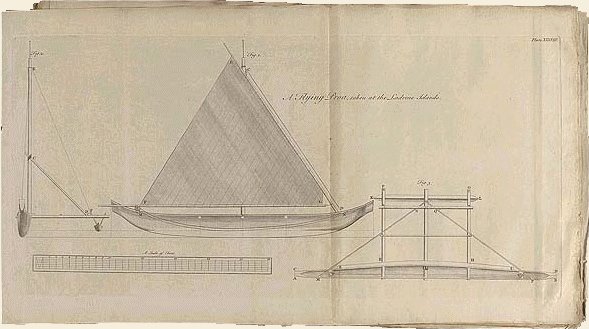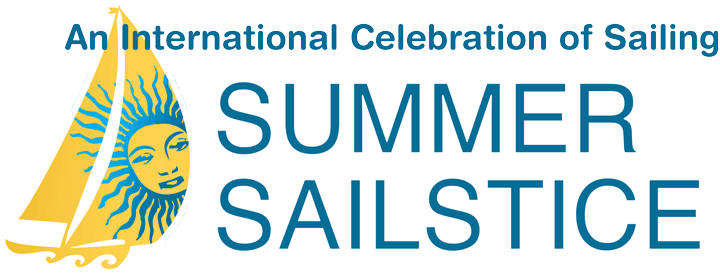
Today, most people sail for pleasure. But it wasn’t so long ago that sailing was serious business. How serious? Think about this: From the decks of sailing ships, continents were discovered. Trade routes were established. Empires formed, flourished and fell. Wars were won or lost, and the fates of nations decided. In fact, the very concept of modern civilization itself keyed on trade routes established by ancient sailors. As recently as the late 19th Century, the captains of sailing ships were the rock stars of their day.
And we think Summer Sailstice might be a good time to celebrate – not only saiing on the longest day of the year – but also the forefathers (and mothers) in whose wakes we sail. Here’s a very quickie alphabetical list of just a handful of them (sans “Q” or “X” names, which we couldn’t find). We encourage you to include at least one of these – or some historical sailing figure of your own choosing - in at least one toast on the Summer Sailstice weekend, June 20-21. And please let us know who it is!
A – As well as discovering the South Pole and making it to the North Pole, the Norwegian-born Roald Amundsen was the first to successfully traverse the Northwest Passage in1903-1905.
B – He may have been an SOB, but you have to hand it to William Bligh: he was a superb seaman and navigator. After Fletcher Christian kicked him off the Bounty in mid-ocean in 1789, he and 18 loyal men survived a 3,600-mile voyage to safety a 23-ft open boat.
C – Christopher Columbus is the obvious one here. But also consider the great Captain James Cook, who explored and charted much of the South Pacific in the mid-1700s.
D – Talk about rock stars! Sir Francis Drake was, at one time or another, a privateer, navigator, slaver and politician. He also made a circumnavigation aboard his Golden Hind between 1577 and 1580.
E – Widely considered the first European to set foot on North America, Leif Ericson and his crew landed in Vinland (Newfoundland) in the year 999. Columbus wouldn’t “discover” the rest of America for another 500 years.
F – In 1864, in the Battle of Mobile Bay, David Farragut uttered the now immortal “Damn the torpedos, fill speed ahead.” He went on to become the first Admiral in the U.S. Navy.
G – Portuguese by birth, Vasco De Gama’s claim to fame is finding the sea route from Europe to India on a voyage from 1497-99. It would be 100 years before the English and French were able to break the trade monopoly he established.
H – How’s this for serious: In Massachusetts, there is a grave maker which reads: “Captain Freeman Hatch, 1820-1889. In 1852 he became famous for making the astonishing passage in the clipper ship Northern Light from Frisco (sic) to Boston in 76 days, 6 hours, an achievement won by no other mortal before or since.” (Note: Northern Light’s record was broken in 1993 by a modern trimaran, but her monohull record still stands.)
I – Old Ironsides. Okay, it’s a ship, not a person. But if there was ever a sailing ship worth clinking glasses over, this is the one. USS Constitution gained enduring fame during an 1812 engagement with HMS Guerriere. When British cannonballs were seen bouncing off her hull, one sailor was hear to yell, “Huzzah, her sides are made of iron!” Still a commissioned Navy vessel, Old Ironsides is currently docked in Boston.
J – In 1779, during a contest with the larger, more heavily armed British frigate Serapis, John Paul Jones’ Bon Homme Richard was pounded almost to smithereens by the larger ship. On fire and sinking, Jones was demanded to surrender. His retort - “I have not yet begun to fight!”Apparently, he hadn't. He went on to win that engagement and sail home on the captured Serapis.
K – The practice of ‘shanghaing’ was rampant on the west coast in the late 1800s. Among the most infamous crimps was Jim “Shanghai “ Kelly. His most notable escapade was inviting a big crowd onto a chartered boat for his “birthday cruise,” giving them all opium cocktails, and reportedly delivering upwards of 100 of the poor unconscious schmucks to three waiting ships – all in one night.
L – During the War of 1812, James Lawrence, commanding the USS Chesapeake, engaged the British frigate HMS Shannon. Struck down by small arms fire, with his dying breath he ordered, “Don’t give up the ship!”
M – Although credited with the first-ever circumnavigation, ironically, Ferdinand Magellan didn’t live to see it. Nor did most of his men. Of five ships and 237 men that departed Seville in 1519, only one, Victoria, made it home in 1522 with only 18 men.
N – In December, 1854, under the command of Captain Alexander Newlands, the clipper Champion of the Seas reeled off 465 miles noon-to-noon. This day’s run record remains the fastest for any commercial sailing ship, and stood for 130 years before finally being broken in 1984 by a modern multihull.

Of course who knows how far an original South Pacific multihull might have traveled in ancient times? More about the recontrstruction of a Marianas Sakman.
0 – Captain Jeremiah O’Brien of the sloop Unity – and a crew of 31 armed with swords, axes, pitchforks and only a few guns - captured the British armed schooner HMS Margaretta in 1775 off Boston. Despite the fact that there was no Continental Navy at the time (Unity was a merchantman), this is considered the first naval battle of the Revolutionary War.
P – On a passage from Boston to San Franicsco in 1855, the first mate of the clipper Neptune’s Car was slapped in irons for trying to incite a mutiny. The captain, Joshua Patten, took ill off Cape Horn. His wife, Mary Patten, whom he had taught navigation, took over command of the ship and got her safely into San Francisco. At the time, Mary was only 19 years old - and pregnant.
R - Piri Reis was an Ottoman Admiral, geographer and cartographer. Using information he compiled from various voyages he went on himself, as well from as charts and notes from other explorers (including Columbus), he amassed a huge body of charts detailing most of the known world in the early 1500s – including much of what the coast of Antarctica looks like. How he did the latter remains anybody’s guess, since it hasn’t been ice-free since 4000BC.
S – Although Ernest Shackleton is renowned as an Antarctic explorer, his 800-mile voyage in a 20-ft open boat (after his ship Endurance was crushed by ice) ranks as one of the all-time epic small boat voyages of all time. He and a small crew made it to civilization, then returned to rescue all the men he had left behind.
T- Gotta have at least one rascal in the bunch, and Edward Teach, better known as Blackbeard, was a rascal’s rascal. An English pirate whose hunting grounds extended from the east coast to the Caribbean, Blackbeard was one of the first purveyors of “shock and awe.” Physically large and imposing to begin with, before going into battle, he’d strap many guns and swords to himself, then stick lighted matches in his hair and beard. Many people were so scared at just seeing him that they would surrender their ships or goods. Killed in a surprise attack in 1719, it took 5 gunshots and 20 sword wounds to bring him down.
U – In 1536, Spain’s Andres de Urdaneta commanded the second world circumnavigation, but (since Magellan didn’t survive the first one), became the first commander to see it through. Routes established by Urdaneta were later used by the Spanish treasure fleets.
V – Italian by birth but later granted Spanish citizenship, Amerigo Vespucci was a master navigator who was along for several voyages to the west after Columbus. Letters attributed to him literally put the New World on the map. In his honor, a cartographer of the time called the place America. And the rest, as they say, is history.
W – Okay, again, it's not a person. But Jack London's novel The Sea Wolf - like Robinson Crusoe and Moby Dick - is based on real people and events. In the case of The Sea Wolf, London's Wolf Larsen was modeled after Captain Alexander McLean, a Nova Scotian who mostly sailed the Pacific Northwest and was once the Sheriff of Nome, Alaska. And, we're guessing, was not the most sociable guy in the world.
Y- During the American Revolution, Captain John Young gained fame by taking many enemy ships as prizes. On his first cruise aboard Independence, he nabbed two prizes on the way to France. Later, commanding the new sloop-of-war Saratoga in 1780, he nabbed one prize — during her shakedown cruise! — and racked up nine more before Saratoga disappeared without a trace in 1781.
Z – Zheng He was a Chinese explorer and diplomat who commanded China’s treasure voyages during the Ming dynasty in the early 1400s.
